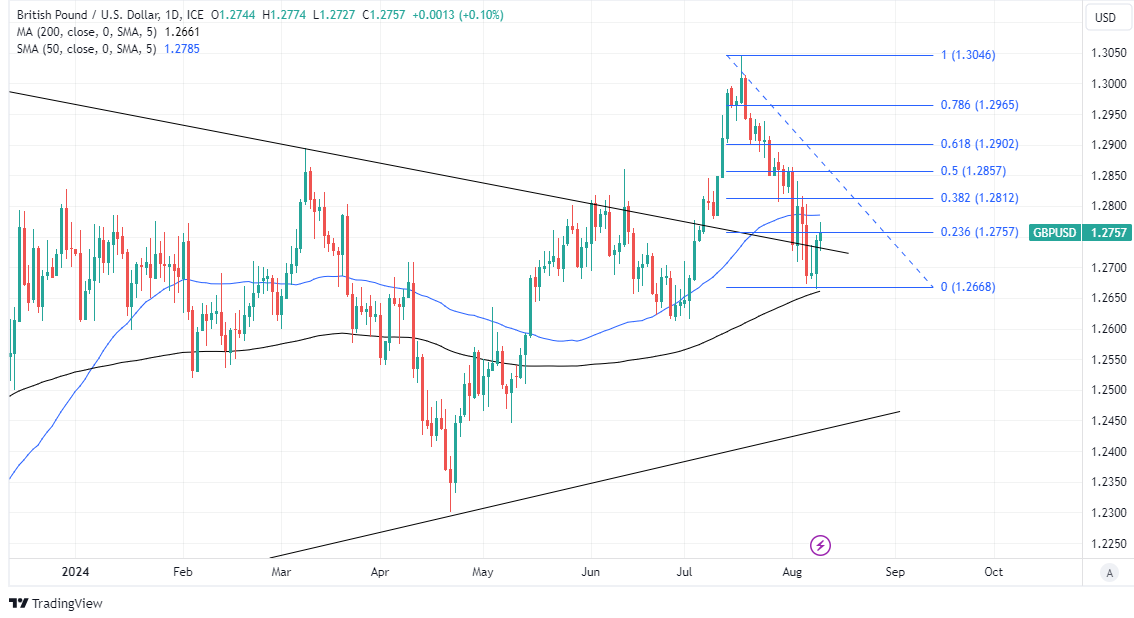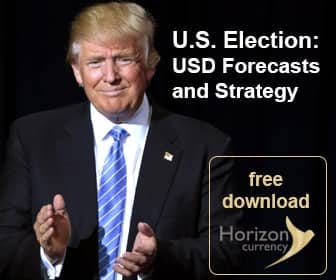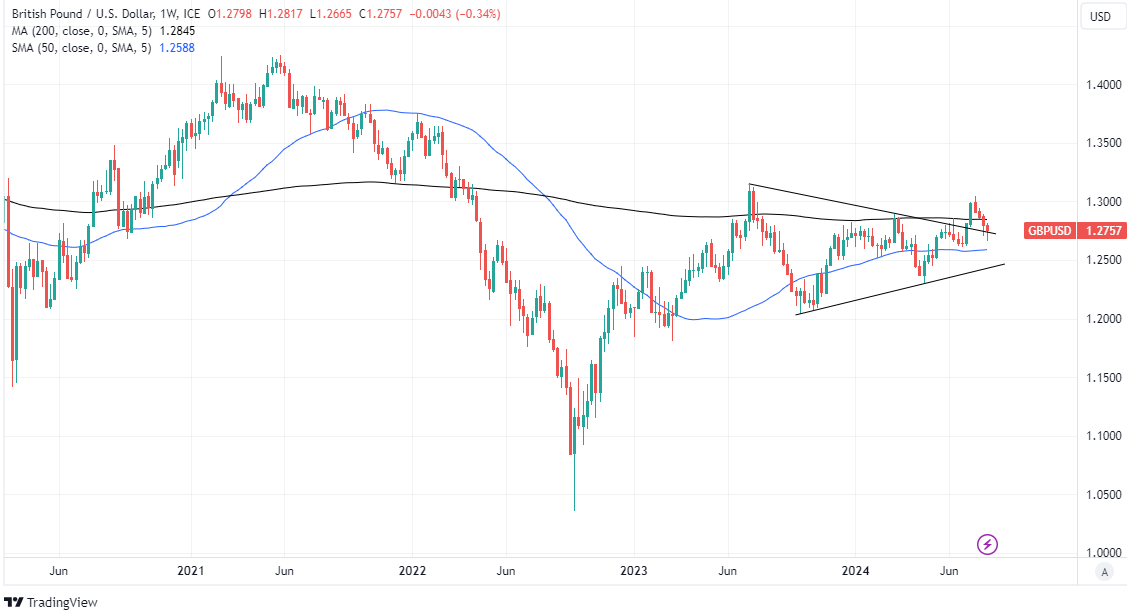GBP/USD Week Ahead Forecast: US Election Polls, CPI Aid Recovery
- Written by: James Skinner

Image © Giuseppe Milo, CC BY 2.0. Source
The Pound to Dollar exchange rate has steadied following a steep sell-off in late July and early August but there are multiple reasons for thinking it could have scope to recover further lost ground in the days ahead, with a retest of the 200-week average up around 1.2845 a credible prospect.
GBP/USD steadied atop its 200-day moving average at 1.2661 last week before paring some of its recent losses but better risk appetite in global markets, the latest US election polls and the consensus outlook for inflation on both sides of the Atlantic are among the factors that could help lift it further ahead.
“Kamala Harris leads Donald Trump in three key states—Michigan, Pennsylvania and Wisconsin—according to a new New York Times/Siena College poll. The betting markets currently imply probabilities of an election win as follows: Harris at 52%, Trump at 45%,” said Alessio Farhadi, co-founder at Speevr Intelligence.
“Recent trends in surveys have been favorable to Harris across a broad category of voter demographics, not just the young. It was agreed with our GOP strategist friends/partners that a +5% increase for Harris in national polls is a soft trigger to panic,” he added in a Friday research briefing.
Above: Pound to Dollar rate at daily intervals with Fibonacci retracements of July rally, 200-day moving average, and black trend lines denoting a narrowing symmetric triangle indicate possible areas of technical support. 50-day average and Fibonacci retracements of July downtrend highlight possible resistances. Click image for closer or more detailed inspection.
Democratic Party presidential candidate Kamala Hariss has turned the tables on former President Donald Trump in many recent opinion polls, which is undermining one important source of support for the US dollar and its outlook into year-end because Trump’s protectionist trade policy agenda and trigger happy use of tariffs is outright bullish for business investment, production, employment and GDP in the US.
However, any more immediate boost for GBP/USD would be likely to come from inflation on both sides of the Atlantic on Wednesday, in part because the ongoing disinflation process in the US should see markets continue to bet that the Federal Reserve will cut interest rates by as much as 100 basis points by year-end, weighing on the Dollar. Meanwhile, UK inflation poses asymmetric upside risk to Sterling.
“The June CPI report brought welcome news of slowing inflation, with core CPI rising by a mere 0.06% m/m, marking the smallest increase since January 2021. While we expect a bit of a firmer report in July, we still expect it to be “very good” in the eyes of Fed policymakers,” BNP Paribas economists said on Friday.
Consensus sees US inflation rising 0.2% month-on-month when data for July is released on Wednesday, which is expected to pull the annual inflation rate down to 2.9%, from 3% in June. This keeps the US disinflation process intact and should weigh on the Dollar because it has a loose negative correlation with inflation.
Above: Quantitative model estimates of possible ranges for the week. Source: Pound Sterling Live.
Compare Currency Exchange Rates
Find out how much you could save on your international transfer
Estimated saving compared to high street banks:
£25.00
Free • No obligation • Takes 2 minutes
UK inflation, on the other hand, is seen rising to 2.3% annually in July after remaining at the 2% target for a second consecutive month in June. This is potentially bullish for GBP/USD in the short-term because, rightly or wrongly, it could lead the market to expect that interest rates will remain higher for longer than otherwise.
“While headline inflation has been at 2% for 2 consecutive months, the BoE itself forecasts a rise to 2.7% by the end of the year before a return to target in 2026,” BCA Research strategists said on Friday.
However, the Pound to Dollar rate has been negatively correlated with the twists and turns of the inflation cycle since at least January 2021, which implies that Sterling would also have scope to rise in the latter half of the week if inflation surprises on the downside of expectations.
Disinflation on both sides of the Atlantic would imply scope for GBP/USD to further close the gap between itself and fair value, which is estimated to be around 1.3796, up from around 1.3515 at the beginning of the year. The author’s fair value model uses inflation, interest rates and the cross-currency differentials between both to estimate where currencies should trade as inflation rises and falls.
Above: Pound to Dollar rate shown at weekly intervals with 50-week moving average (blue) and upper bound of narrowing symmetric triangle indicating possible areas of technical support. 200-week average(black) indicates possible short-term technical resistance.










